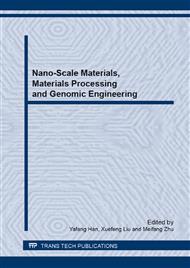[1]
Q.Z. Xu, C.H., Liang, Development of Thermal Barrier Coating for Foreign Turbofan Engine Turbine Blade, Aeroengine, 34 (3) (2008) 52-56.
Google Scholar
[2]
L.M. He, High-temperature Protective Coating, 2012.
Google Scholar
[3]
H.J. Wang, Thermal spraying materials and application, 2008.
Google Scholar
[4]
W. Chang, Y.L. Ji, W.M. Yuan, The actuality and standard requirements and technology development of Aero engine high temperature protective coatings, Aviation standardization and quality, 1 (2013) 10-13.
Google Scholar
[5]
J.Y. Xiang, S.H. Chen, Research progresses of rare-earth zirconate ceramic materials for thermal barrier coatings, Materiala Review, 26 (1) (2012) 147-151.
Google Scholar
[6]
J. Peng, Y.T. Sun, Study on Microstructure and Properties of Nano-ZrO2 Thermal Barrier Coatings Fabricated by Plasma Spraying Technology, Thermal Spray Technology, 2 (2012) 12-15.
Google Scholar
[7]
W.Q. Wang, C.K. Sha, Microstructural feature, thermal shock resistance and isothermal oxidation resistance of nanostructured zirconia coating, Mat. Sci. and Eng. A 424 (2006) 1-5.
DOI: 10.1016/j.msea.2005.10.025
Google Scholar
[8]
Y.L. Deng, B.B. Li, Coal ash refining and its application for environment, Sichuan Environment. 31 (1) (2012) 97-103.
Google Scholar
[9]
W.B. Gong, C.K. Sha, D.Q. Sun, W.Q. Wang. Microstructures and thermal insulation capability of plasma-sprayed nanostructured ceria stabilized zirconia coatings. Surface & Coatings Technology, 201 (2006) 3109-3115.
DOI: 10.1016/j.surfcoat.2006.06.041
Google Scholar
[10]
X.D. Cheng, J. Min, Microstructure and thermal shock resistence of solution precursor plasma spray nanostructured ZrO2 TBCs, Journal of Aeronautical Materials, 32 (10) (2012) 23-27.
Google Scholar
[11]
J. Meng, X.Q. Cao, Thermalstability of double-ceramic-layer thermal barrier coatings with various coating thickness, Materials Science and Engineering, 433 (2006) 1-7.
DOI: 10.1016/j.msea.2006.04.075
Google Scholar
[12]
Z.B. Wang, C.G. Zhou, H.B. Xu, S.K. Gong, Effect of Thermal Treatment on the Grain Growth of Nanostructured YSZ Thermal Barrier Coating Prepared by Air Plasma Spraying. Chinese Journal of Aeronautics, 17 (2) (2004) 119-123.
DOI: 10.1016/s1000-9361(11)60224-0
Google Scholar
[13]
R.D. Mu, Z.H. Xu, S.M. He, Electron Beam Vapor Deposited La2Zr2O7 Thermal Barrier Coaings, Journal of aeronautical materials, 29 (1) (2009) 32-36.
Google Scholar
[14]
Q.Q. Xian, S.L. Liu, Polarization of electrode, Plating & Finishing, 30 (6) (2008) 28-30.
Google Scholar


